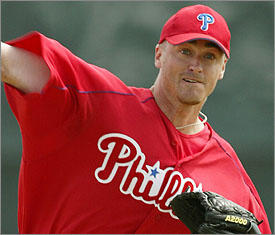Thursday, July 14, 2005
Player Profile: Brett Myers
 Brett Myers was the Phillies first selection in the 1999 draft. A big part of the Phillies plans for several seasons, Myers was expected to be a big reason why the Phillies 2004 rotation, which boasted Kevin Millwood, Eric Milton, Randy Wolf and Vicente Padilla, was supposed to be one of the best in the National League. Naturally, things did not work out that way. Myers had an awful year in 2004, surrendering 31 home runs on his way to a 5.52 ERA, an 11-11 record and a 1.47 WHIP. Many doubted Myers would recover. I was optimistic, noting that Myers 31 home runs seemed a fluke: his groundball-flyball ratio was a robust 1.39. He seemed like a pitcher who could succeed at Citizens in a way that Eric Milton couldn't because he threw groundball pitches.
Brett Myers was the Phillies first selection in the 1999 draft. A big part of the Phillies plans for several seasons, Myers was expected to be a big reason why the Phillies 2004 rotation, which boasted Kevin Millwood, Eric Milton, Randy Wolf and Vicente Padilla, was supposed to be one of the best in the National League. Naturally, things did not work out that way. Myers had an awful year in 2004, surrendering 31 home runs on his way to a 5.52 ERA, an 11-11 record and a 1.47 WHIP. Many doubted Myers would recover. I was optimistic, noting that Myers 31 home runs seemed a fluke: his groundball-flyball ratio was a robust 1.39. He seemed like a pitcher who could succeed at Citizens in a way that Eric Milton couldn't because he threw groundball pitches.Myers is off to a strong start in 2005 and has stepped up to become the Phillies ace in a way that Jon Lieber hasn't. Myers is 6-5, but his record doesn't even come close to showing how well he's pitched. In six of his seven no-decisions Myers surrendered two runs or less. His record could easily be 12-5 right now. Myers ERA is an impressive 3.20, more than two runs lower than it was in 2004. Let's start by noting how much better Brett is doing this year as compared with last:
2005 / 2004
ERA: 3.20 / 5.52
WHIP: 1.14 / 1.47
K/9: 8.82 / 5.93
BB/9: 2.73 / 3.17
HR/9: 1.09 / 1.58
Myers has cut down on home runs, which obviously has had a large impact on his ERA. A tremendous change not simply explained by the "luck" factor: namely his nearly three extra strikeouts per 9 innings is a big jump in performance, not attributable to his renewed ability to prevent surrendering the longball. He seems to have newfound velocity on his pitches.
What's interesting is to look deeper into Brett's stats. Here is now he did in 2004 on a few "sabremetric" pitching stats:
FIP: 5.20
DER: .707
G/F: 1.39
He pitched better than his ERA indicates, though there is scant different between a 5.20 and 5.52 ERA. I note that he did keep the ball down and the Phillies played good defense (but not great, as in the case of Eric Milton: .737 DER) behind him. I really felt he could do better and he really has:
2005:
FIP: 3.74
DER: .727
G/F: 1.44
His FIP indicates that he isn't quite pitching as well as he seems, but those are stats Phillies fans want to see: keeping the ball down, giving the fielders a chance to make plays.
Is Brett the Phillies ace current and future ace? Right now he is, though I had expected Jon Lieber to fulfill that role. Brett is largely carrying the Phillies starting rotation:
Myers / Starters
ERA: 3.20 / 4.28
WHIP: 1.14 / 1.35
K/9: 8.82 / 6.54
BB/9: 2.73 / 2.96
HR/9: 1.09 / 1.28
Corey Lidle is pitching well, but now that Brett has come into his own he's clearly the Phillies best pitcher: he's young (just 24) and has a great future ahead of him because of his ability to notch strikeouts and keep the ball down. He should be able to get Part II of the Phillies season off to a strong start tonight against the Marlins.
Confused about what I’m talking about? Here are the stats I refer to defined:
WHIP – Walks plus hits by innings pitched: (BB + H) / IP = WHIP
ERA – Earned Run Average: (Earned Runs * 9) / IP = ERA
FIP – Fielding Independent Pitching: (13*HR+3*BB-2*K / IP) + League Factor Evaluates a pitching by how he would have done with an average defense behind him by keeping track of things that a pitcher can control (walks, strikeouts, home runs allowed) as opposed to things he cannot (hits allowed, runs allowed).
DER – Defense Efficiency Ratio: (Batters Faced – (Hits + Walks + Hit By Pitch + Strikeouts)) / (Batters Faced – (Home Runs, Walks + Hit By Pitch + Strikeouts)) How often fielders convert balls put into play into outs.
G/F – Groundball-to-Flyball ratio.
Hr/9 – Home Runs allowed per nine innings.
K/9 – Strikeouts per nine innings.
BB/9 – Walks per nine innings.
Comments:
Myers hasn't pitched all that well in four of his last five starts. Moreover, he is beginning to revert to form temperamentally. As for keeping the ball down, he as shown a tendency of late to give up the long ball. He could be the staff ace were he to calm down, but his volatility is an ongoing problem.
Post a Comment












